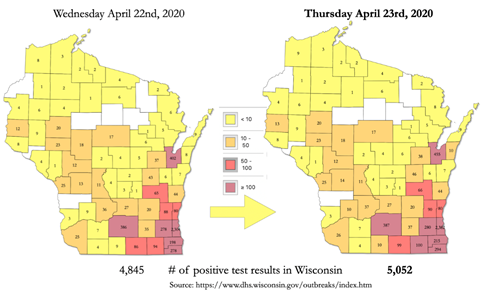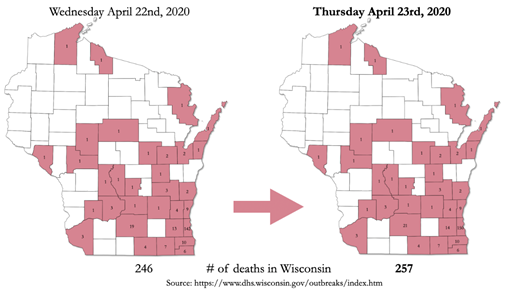Arkansas
As of April 23rd
Governor Hutchinson announced a goal of increasing testing from 1,000 to 1,500 per day over the next two days. As more people get tested Friday and Saturday, we may have a clearer picture of the presence of COVID-19 in Arkansas.
Georgia
As of April 24th
- Daily State Public Health stats: As of noon Friday, State cases are up to 22,147 confirmed cases as compared to 21,883 at 7 p.m. Thursday, with 4,221 hospitalized patients as compared to 4,154 last night, and 892 deaths as compared to 881 last night.
- Per https://covid19.healthdata.org/united-states-of-america/georgia, IHME now predicts that Georgia reached our peak on April 15 and that relaxed social distancing may be able to start June 15.
- Initial unemployment claims in Georgia dropped for the second consecutive week. Initial unemployment claims in GA for the week ending April 18 were 243,677, down 75,904 or 24 percent. In the past five weeks, more than 1m initial unemployment claims have been made in GA.
- Advanced practice nurses are urging Gov. Kemp to suspend the state’s restrictions on them, requiring supervision by a doctor.
- Almost 760,000 have applied to vote by mail in GA. Over 60,000 have never voted here before. 193,000 have never voted in a primary before.
Missouri
As of April 23rd
Missouri is now reporting 6,137 cases of coronavirus and 240 deaths. One week ago, we were at 5,111 cases and 152 deaths. Although Missouri is experiencing slowdown in the growth of new cases, hotspots have arisen in Saline and Moniteau counties because of outbreaks tied to three meat processing facilities.
More Budget Withholds
Governor Parson announced another $47 million in budgetary withholds this week. The largest items included in the spending restrictions are:
- $15,865,787 K-12 Foundation Formula
- $7,100,000 K-12 Transportation
- $4,850,000 Electronic Monitoring Pilot Program
- $4,772,837 MO Healthnet Transformation Initiatives
- $3,968,860 Senior Services Growth and Development Program
- $3,400,000 Statewide Accounting and Budget System Replacement Program
- $1,800,000 Rural Broadband Grants
What We Expect When the General Assembly Returns on Monday
The biggest priority for the legislature’s return is the Fiscal Year 2021 budget. Currently the budget bills are on the House Calendar awaiting Perfection. When those budget bills were drafted, the Coronavirus had not yet impacted the state’s budget forecast. However, due to the virus’s impact over the last six weeks, it is expected that the General Assembly will cut approximately $700 million from those budget bills to balance the budget. Legislative leaders have cautioned that what they do with the budget in the next two weeks is just a snapshot of the budget projections based on the information they have right now. It is expected that as the state re-opens for business, taxes are filed in July, and more federal money (possibly) becomes available, they will have to come back and pass a supplemental budget in the summer and/or fall.
Although the budget is the top priority of the Governor and legislative leaders it is expected that there will be some policy issues tackled during these three weeks as well. Some of the items that could be discussed include:
- Tort reform
- CLEAN(er) Missouri
- Prescription Drug Monitoring Program
- Broadband expansion
- Extending the sunset on 5G legislation
- Natural gas infrastructure
- Wayfair
Other Actions
Governor Parson has begun to piece together the “Show-Me Strong” recovery plan to safely and gradually reopen Missouri’s economy, beginning on May 4. He will begin to outline the specifics of this plan next week.
Governor Parson announced that the working group that he formed to provide recommendations on how to best spend billions of dollars in federal stimulus money will hold public meetings. He also added two Democrats to the group. The working group is chaired by State Treasurer Scott Fitzpatrick and also includes State Budget Director Dan Haug, Public Service Commission Chairman (and former House Budget Chairman) Ryan Silvey, House Budget Committee Vice Chairman David Wood, House Budget Committee Ranking Minority Member Rep. Kip Kendrick, Senate Budget Committee Member Lincoln Hough, Senate Budget Committee Member Karla May, Legislative Liaison for the Department of Natural Resources Rich Germinder, and Legislative Director for Sen. Roy Blunt, Dan Burgess.
Oregon
As of April 24th
In this week’s update:
- President Trump signed a $482 billion “interim” federal stimulus today
- The U.S. Supreme Court issued a ruling in Ramos v. Louisiana, which ended non-unanimous juries in Oregon.
- Oregon’s Legislative Emergency Board met yesterday, and allocated $50 million in COVID-19 response funding, including $10 million to the Oregon Worker Relief Fund to assist immigrant Oregon workers left out of the Federal Stimulus package
- Governor Kate Brown outlined a plan for a phased re-opening of Oregon’s economy, and issued an executive order allowing non-urgent medical procedures to resume on May 1
- Oregon’s Supreme Court issued a ruling that says campaign finance limits do not violate the state constitution, setting off a scramble to understand the immediate impact on this year’s election cycles, and paving the way for local and state campaign contribution limits.
- Portland City Council authorized $100 million in revenue bonds in case additional funds are needed to address revenue short falls in the next fiscal year, and received $114 million in federal stimulus dollars—plus a budget update.
- And more!
State:
- Legislative Emergency Board met Thursday: The long-awaited meeting of the E-Board happened yesterday and was held virtually. Much of the agenda and funding allocation went as planned, except for the $50 million in loans slated to go towards supporting rural hospitals. There was clear disagreement been legislative leadership and other E-board members on whether the $50 million should be loans or a combination of forgivable loans or grants. The agenda item was tabled until the next meeting of the E-board, which is not scheduled. You can see the full agenda and watch the full recording of the meeting here. Below is a list of expenditures:
- $12 million for Housing Assistance. Includes hotel vouchers for farmworker quarantine housing and hotel vouchers for the homeless (requested by community action agencies). Rent relief payments directly to landlords through housing agencies.
- $5 million for Small Business Stabilization. Payments to small businesses who aren’t being assisted by federal funds. This will be matched by $5 million in existing Business Oregon funds, for a total of $10 million.
- $2 million in Domestic Violence Funding. This will be allocated via the Department of Justice directly to non-profit providers of domestic violence services.
- $10 million in Worker Gap Funding. These will be payments to workers who are excluded from federal assistance via the Oregon Worker Relief Fund (e.g., because of their documentation status).
- $120,000 for a Pandemic Human Resource position to coordinate pandemic response at the Bureau of Labor and Industries.
- $3.35 million for COVID Testing and Training of workers in long-term care and other congregate-care settings. (This may not be needed if Oregon can use federal funds for this purpose.)
In addition to these direct allocations from the Emergency Fund, the E-Board also granted approval for spending of federal dollars and other fee-based dollars coming to the state. These include some that are COVID related (e.g., $300 million in general federal COVID Relief Funds).
- Governor Brown announced criteria for reopening the state: In a press conference last week, Brown outlined what needs to happen before the state is ready to reopen for business: she wants to ensure the state has a robust testing, tracing and isolation strategy, and she needs to feel confident the state has enough hospital beds to treat any surge of COVID-19 cases and enough protective gear for healthcare workers. We are hearing a more detailed plan may be released soon. Local media posted the Governor’s draft plan for reopening Oregon’s economy.
- Governor Brown announced that non-emergency medical procedures can resume on May 1, allowing hospitals, surgical centers and medical and dental offices that can meet the new requirements to start performing many standard procedures late next week.
- Governor Brown announced the Oregon National Guard will distribute nearly 400,000 pieces of personal protective equipment (masks, gloves, and face shields) to long-term care facilities throughout the state. The PPE will be distributed to all of the state’s nursing homes and other long-term care facilities. Members of the Oregon National Guard began deliveries of this equipment Saturday.
- The Oregon Supreme Court upholds paid sick leave: Linn, Douglas and Yamhill counties sued Labor Commissioner Val Hoyle and Gov. Kate Brown in 2016. They argued that the requirement for paid sick leave amounted to an unfunded state mandate on local governments and they were not subject to the law. The Supreme Court disagreed.
- What about colleges? On April 17, Gov. Brown amended her Higher Education executive order requiring Oregon public and private colleges/universities to offer only online instruction — extending it from 4/28 through the end of the spring term. Only a limited number of health care and emergency response/resiliency courses are exempt from this order and can continue face-to-face if social distancing safeguards are met. Her prior order resulted in the cancellation of hundreds of spring term courses across Oregon that require face-to-face instruction (and the layoffs of hundreds of higher ed faculty). Negotiations are currently underway to enable more courses that require face-to-face instruction (welding, manufacturing, automotive, etc.) to be allowed during summer term if social distancing safeguards are met.
Local:
- Oregon Supreme Court rules campaign contribution limits are legal: The court ruled that $500 campaign limits adopted by an overwhelming majority of Multnomah County voters in 2016 do not run afoul of the state constitution. It sends the case back to a lower court to decide whether Multnomah County’s dollar limits themselves are too low, while tossing out limits that Multnomah County voters set on campaign expenditures. This is a developing story and we will continue to update folks as we learn more about the implications of this decision in Multnomah County and statewide.
- City Council passes $100 million in revenue bonds: Last week, Portland City Council authorized $100 million in revenue bonds in case additional funds are needed to address revenue short falls in the next fiscal year.
- City update on CARE Act funds: This week Portland City Council held a work session this week regarding the CARES Act and City budget forecast and process for fiscal year 2020-21. The City has received $114 million directly for COVID-19 response (which are not accounted for in the current fiscal year 2019-20 budget) and has received the following limited guidance for use of the federal funds:
- Funds can be used only for necessary expenditures related to COVID-19 response
- Funds cannot be used to backfill lost revenue
- Funds are applicable for expenditures incurred between March 1 – December 30, 2020
Additional guidance from the federal government for how funds can be spent is imminent, but on an unknown timeline with unknown parameters, which is frustrating local leaders. Next steps regarding the CARES Act City-received funds are:
- The City Administrative Officer and Office of Management and Finance resumes assessing the bureau needs assessment for current and projected CARES Act funding expenses, which includes City bureau directors, City Council, and Multnomah County, and
- The City develops a decision-making process to review and allocate CARES Act funding to be spent by December 30.
- City budget forecast and budget process update: The City economist updated the City’s budget forecast to reflect an incredible amount of uncertainty. For the current fiscal year 2019-20 budget, General Fund revenues are likely to mostly meet current year revenues as expected and budgeted. Immediate exceptions are Portland Parks and Recreation (PP&R) and the Portland Bureau of Transportation (PBOT), with the Bureau of Development Services (BDS) likely to follow, as BDS expects permits to decline in the next 3-6 months.
The forecast for the upcoming fiscal year 2020-21 includes:
- A 30% decrease in the Business License Tax (BLT), a loss of about $45 million
- A $20 million decrease in Transient Lodging Taxes (TLT), which is a more than 50% decline
- Property taxes and utility license taxes and franchise fees will likely see increased delinquency rates, although the timing and magnitude are uncertain
- Overall, $75 million less in General Fund revenue than previously forecasted in February (a 13% decrease)
Budget Implications and Process Update
Cuts and reductions for the upcoming fiscal year 2020-21 include:
- Eliminating forecasted revenues ($28.5 million)
- Capturing as much current fiscal year savings as possible
- Reallocating non-urgent program and policy set-asides
- Including as many reductions as possible this spring to set the City up for the fall
- Establishing a renewed bureau/programmatic reduction target for fall 2020
- Truing-up the fiscal year 2020-21 budget in the fall for when more information is known regarding revenues and expenditures, which will likely mean setting reduction targets for bureaus this fall
- Metro Council town hall on potential transportation funding ballot measure: Metro Council held their first virtual work session to discuss the potential regional transportation funding ballot measure referral for November. Metro staff discussed a potential measure that would likely rely on a business tax based on wages paid and an increased business registration fee, in response the homeless services measure voters will consider on May 19, which relies on a high-earner income tax and tax on the profits of large businesses. Staff will bring updated revenue estimates, a proposed expenditure plan, and letters of commitment from local agencies to deliver projects at a future date. Work continues with the task force to bring a proposal to the Metro Council for referral by June or July.
Upcoming Virtual Town Halls
Many of our partners have been asking about the best way to connect with and engage elected officials right now. As some are moving engagement to virtual town halls, we’ll keep a running list of upcoming events here.
- Senator Rob Wagner (D-Lake Oswego) to host two virtual town halls
- On Tuesday, April 28, Sen. Wagner be joined by Congresswoman Bonamici and several other guests to discuss the impacts of the coronavirus response on education and children’s well-being. The call will be held from 5:00 – 6:00 pm.
- On Wednesday, April 29, Sen. Wagner will be joined by Congressman Schrader and several other guests to discuss the impacts of the coronavirus response on businesses and labor, and pathways to economic recovery. The call will be held from 4:00 – 5:00 pm.
- Email Chief of Staff, Gordon Levitt (gordon.levitt@oregonlegislature.gov), if you would like to attend either of the town halls. He will send you a link, a password, and log-in instructions.
COVID-19 Update:
- Oregon now has over 2,127 confirmed cases of COVID-19, as of 8:00am today, 4/23. There have been 83 deaths.
- Oregon Health Authority (OHA) on Monday night revised guidelines for COVID-19 testing to prioritize impacted populations and all frontline workers. The guidelines continue to allow healthcare providers to make clinical decisions about their patients. In addition, if supplies allow, asymptomatic people within the congregate care or group living systems can be considered for testing. The newly revised guidelines urge clinicians to potentially increase testing for Oregonians who may be at particular risk for contracting COVID-19. These groups include:
- those living or working in congregate care or group living facilities;
- underserved and marginalized populations, including racial and ethnic minority groups;
- essential frontline workers, including those providing healthcare services and those serving the public, such as grocery store workers.
- The new clinical guidelines for testing can be found here.
At-a-Glance: Oregon News Related to COVID-19
- Oregon’s Latino population disproportionately hit hard by coronavirus cases (Oregonian)
- Elections Officials Urge Oregonians To Stay Home, Vote by Mail Using Free Postage (OPB)
- Multnomah County sees first cases of coronavirus in homeless population (Oregonian)
- Oregon coronavirus layoffs total 169,000; Here’s a running tally (Oregonian)
- COVID-19 Could Lead To 1.3 Million on Oregon On Medicaid, Study Says (Lund Report)
- Oregon inmates sue Gov. Brown, Department of Corrections over COVID-19 response (Statesman Journal)
- Oregon prepares for coronavirus surge: New online tool will help track its spread, direct sick to open hospital beds (Oregonian)
COVID-19 RESOURCES
Nonprofits & Small Businesses
- NEW: Fact Sheet on the Paycheck Protection Program from the U.S. Treasury Department
- NEW: Relief for Oregon child care and early education providers
- Oregon’s Small Business Resource Navigator
- Oregon Community Recovery Grant program
- Prosper Portland COVID-19 business resources
- U.S. Small Business Administration Disaster Assistance Loans for small businesses
- Greater Portland, Inc. digest of resources for businesses
CARES Act
- Senate Appropriations Committee overview on CARES Act
- New York Times FAQ on stimulus checks, unemployment, and the CARES Act
General Resources
Virginia
As of April 23rd
The latest in Virginia, as of Thursday, April 23:
Total cases: 10,998
Hospitalizations: 1,753
Deaths: 372
The latest:
· Legislators approved the governor’s amendments to an array of economic bills, but rejected the governor’s bid to move municipal elections from May to November.
· Critics of Gov. Northam’s response to the pandemic demonstrated outside the Capitol, honking horns and waving flags as lawmakers reconvened for the final day of the regular session.
· Unemployment persists across the commonwealth, with job losses rippling through industries.
State delegates and senators reconvened Wednesday, April 22, in makeshift arrangements outside the Capitol and inside the Science Museum of Virginia, where they wrapped up work on hundreds of bills amended by Gov. Ralph Northam.
Legislators agreed to Northam’s plan to suspend approximately $2 billion in proposed new spending in the next biennium due to uncertainty caused by the COVID-19 pandemic. But they rejected his plan to move municipal elections from May to November, noting some voters had already cast ballots. Northam already has exercised his authority to delay congressional primaries scheduled for June 9. Those elections will now be held on June 23.
Measures approved Wednesday by the General Assembly included:
- Delaying a minimum wage hike until May 2021
- Delaying the ability of local government employees to unionize until May 2021
- Accelerating tighter regulations of payday loans, including capping allowable interest and fees at 36 percent annually, to take effect in January 2021.
- Amending casino legislation to designate revenue for public schools.
- Amending transportation funding legislation to delay a new regional sales tax in Central Virginia.
The Democratic-led legislature and governor previously agreed on:
- The Virginia Clean Economy Act, which trades higher consumer electricity bills in exchange for the early retirement of coal plants, greater use of renewable energy and a carbon-free electricity grid by 2050.
- The Clean Energy and Community Flood Preparedness Act, which establishes a carbon dioxide cap-and-trade program and a low-interest loan program to help communities deal with recurrent flooding.
- A bill to authorize localities to remove Confederate monuments.
- Decriminalization of simple possession of marijuana.
The General Assembly will likely be called back to Richmond for a special session in late summer or early fall to re-evaluate state finances and budgeting. By then, officials expect the financial toll of the COVID-19 pandemic to be clearer, allowing for a more accurate view of anticipated revenues.
Localities across the commonwealth do not have that luxury and are moving to revise budget plans, which take effect July 1, to pare back new spending and identify areas for additional savings.
Non-essential businesses in Virginia – including indoor recreation and entertainment businesses, hair salons, and barber shops, museums and fitness centers – remain closed until May 8, and a stay-at-home order remains in effect until June 10. Public schools are closed for the rest of the academic year. Protesters honked horns and demonstrated outside the Capitol on Wednesday to oppose the governor’s response and push for a reopening of Virginia’s economy.
Initial unemployment claims for the week ending April 18 slowed to 82,729 but brought the five-week total of initial claims to 493,501, according to the Virginia Employment Commission. This exceeds the average of all initial claims filed in the past three recessions and, while spreading across industries, particularly affected food service and administrative support jobs. This has led to a disproportionate impact on younger and female workers, according to the commission.
The agency has been overwhelmed by the influx of claims and has struggled to expand staffing and resources to accommodate the surge in demand.
Northam has scheduled a press conference for Friday to discuss the latest in the commonwealth’s efforts to respond to the COVID-19 pandemic.
Wisconsin
As of April 23rd
Thursday Media Briefing:
Wisconsin Governor Tony Evers, Department of Health Services (DHS) Secretary-designee Andrea Palm, DHS Chief Medical Officer Dr. Ryan Westergaard, and Ryan Nilsestuen, Chief Legal Counsel held a briefing for the media today.
Of note in the briefing were the following points:
- There were several questions asked during the media briefing about Phase 1 of the “Badger Bounce Back” plan includes opening K-12 schools;
- Chief Legal Counsel Nilsestuen noted that although the schools being allowed to open is part of Phase 1, schools will likely not be operating as they were in December 2019. He noted there is room in their plan to further define those parameters when we get to Phase 1 and they will also be relying on local input and control from school boards.
- Gov. Evers was asked as a former educator if he personally felt comfortable letting schools restart in the Fall without a vaccine. The Governor said it’s his hope schools will open in the Fall but also cautioned that if we rush things and aren’t thoughtful that it’s possible the risk will be too high to open schools in the Fall.
- There were several questions about the protest planned for Friday on the Capitol Square and the Governor said the Capitol Police will not be enforcing social distancing, and as “good Wisconsinites” he is hoping that the protesters exercising their constitutional rights take the necessary precautions to protect others and themselves.
- Sec. Palm was asked about hospitals being able to restart elective surgeries and noted that they never put in any restrictions on them and that the hospitals will make those decisions when they have the necessary PPE and capacity to start those procedures up again.
- Sec. Palm noted that the daily testing capacity is currently at 10,937. Their goal is to be able to do 85,000 tests per week, a little over 12,000 tests per day. The numbers for Wisconsin that were released today were the result of 2,161 tests.
- The Governor was asked about out-of-work Wisconsinites who are waiting on their UI payments and he acknowledged that although many applications has been successfully processed there is a backlog and noted that the state is rapidly hiring to meet the demand to process those claims.
The entire YouTube Live briefing can be found here.
Gov. Evers Signs Emergency Order #32, Relating to the Operation of an Alternative Care Facility at State Fair Park
Gov. Tony Evers and Wisconsin Department of Health Services Secretary-designee Andrea Palm today signed Emergency Order #32, relating to the operation of an alternative care facility (ACF) at State Fair Park in West Allis. The ACF at State Fair Park will play a critical role in helping hospitals to manage a surge in capacity while providing a safe location for low-acuity COVID-19 patients to isolate and recover, which are essential aspects of federal guidance and the Badger Bounce Back plan.
“I want to thank all of the individuals and organizations who have worked tirelessly over the past few weeks to not only construct a temporary medical facility, but to also bring on board dozens of healthcare professionals who will care for the patients at the ACF,” said Gov. Evers. “The ACF will soon provide an additional tool to the SE Wisconsin region to expand the continuum of care for individuals who have tested positive for COVID-19.”
Emergency Order #32 is available here.
Senate Republicans send letter with questions to Governor Evers
12 of the 19 members of the Senate Republican Caucus sent a letter to Governor Tony Evers requesting answers to 25 questions related to the State of Wisconsin’s response to COVID-19. The questions range from how many people have recovered from the disease to questions to try and understand the science behind the timeline the Governor outlined for reopening the state.
They requested a response prior to April 27th, 2020.
The letter can be found here.
Public Policy Polling poll on President Trump versus Governor’s response to COVID-19 pandemic
On behalf of the advocacy organization Protect Our Care, Democratic polling firm Public Policy Polling released polls today from several presidential battleground states, including Wisconsin.
Of note in the findings:
- 45% approve of the way Pres. Trump is handling the coronavirus, 48% disapprove
- 53% approve of the way Gov. Evers is handling the coronavirus, 37% disapprove
- When it comes to social distancing, 21% think we need more aggressive social distancing measures, 53% think we are currently doing the right thing, 23% think we should relax social distancing measures
- 40% think President Trump is properly balancing reopening the economy and protecting Wisconsinites from the coronavirus, 50% think he isn’t
- 49% think Governor Evers is properly balancing reopening the economy and protecting Wisconsinites from the coronavirus, 39% think he isn’t
Press release from Protect Our Care
Updated numbers released on Thursday:
The Wisconsin Department of Health Services and the Wisconsin Hospital Association released updated numbers on Thursday, of note are the following:
- 51,456 negative test results (cumulative)
- +1,954 over reported on Wednesday
- 5,052 positive test results (cumulative)
- +207 over reported on Wednesday
- 257 deaths (cumulative)
- +11 over reported on Wednesday
- 349 Current Hospital Admissions (146 patients in ICU)
- Hospital admissions are -3 in admissions since Wednesday (ICU patients increased, +9)
Sources:
Wisconsin Hospital Association (WHA) COVID-19 Situational Awareness Update site
DHS COVID-19: County Data; https://www.dhs.wisconsin.gov/covid-19/county.htm
Daily numbers:
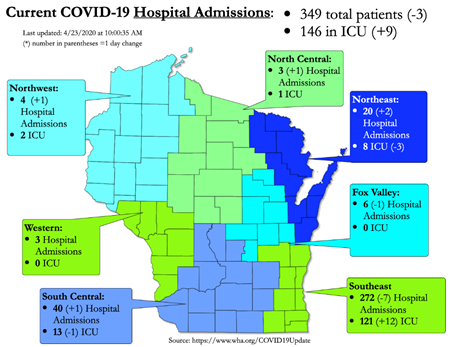
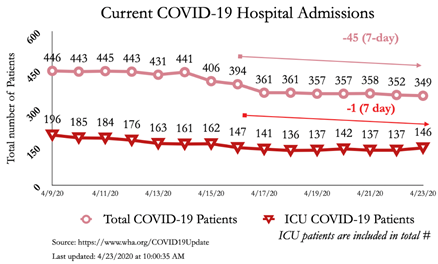


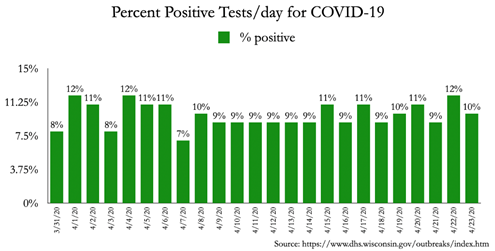
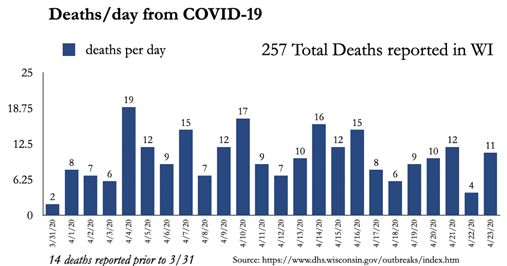
Cumulative Numbers:
